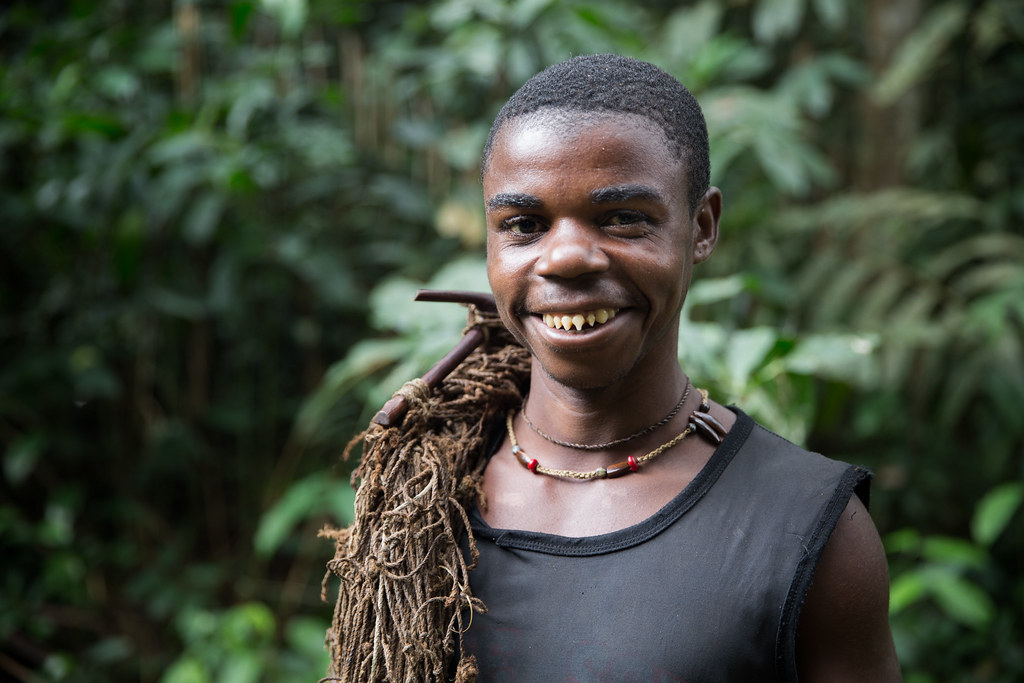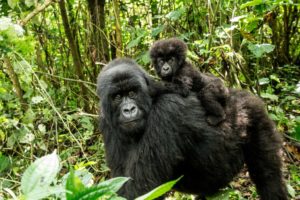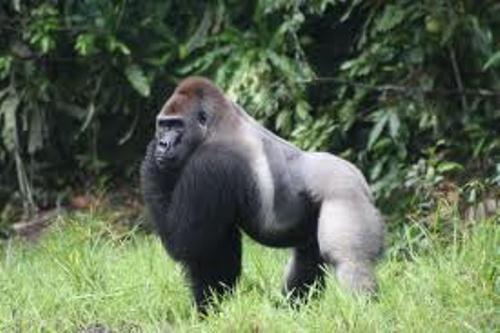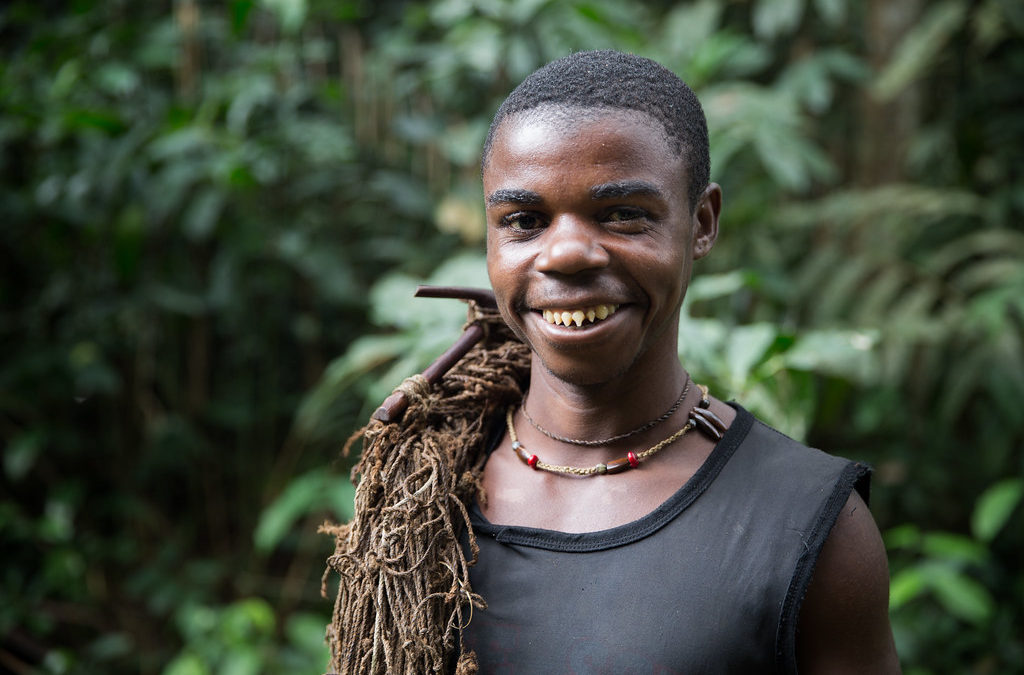Central African Republic: Hunting with the Pygmies, Gorilla Love, and Other Stories (2009)

Mali: Fran versus the Diviner of the Desert
January 3, 2020
Micronesia: Yap, Chuuk, Ifaluk, and Pohnpei – Stone Money, Underwater Airplanes, and More
July 7, 2020Central African Republic: Hunting with the Pygmies, Gorilla Love, and Other Stories (2009)
By Rich Juro
I. The Arrival
It was with excitement and some trepidation that we boarded the small prop plane that would take us from Douala, Cameroon, to the southwest corner of the Central African Republic. C-A-R, as it is known, is located in the center of Africa. Its about the size of Texas, but under 5 million people.
We were flying over the savannas and forests of West Central Africa. Eventually, there was a clearing in the treetops, and we spotted the dirt landing strip. The pilot lowered the nose to glide in to land. As we neared the ground, all of a sudden the pilot gunned the engine and pulled up the plane. We cleared the trees ahead. Then we circled around to try to land again. But as we got down for the second time toward the landing strip, the pilot again pulled the plane up over the surrounding forest.
We were getting worried: Were the wheels not lowering? Were the locals not permitting us to land? What was going on? Fran and I gripped our hands together. We are not religious people, but a little prayer was spoken.
Now the plane had circled again and was dropping down for the third time. This time the pilot completed the descent and we bumped along the dirt runway, turned around toward the little shack that was the “terminal”. When we stopped, the pilot announced: “The reason we couldn’t land the first two times was that there were big tires on the landing strip. The local officials know that tires will deter an armed landing of rebels. When they realized we were not a threat to their security, they cleared the tires and let us land.”
II. The Nation
The Central African Republic has a troubled history. Centuries ago, slave traders brought people north to the Arab lands and west to be shipped to the Americas. In the 1880’s, France colonized the area and called it Ubangi-Shari. Private companies had carte blanche to exploit the land. For example, almost 20,000 Africans died building the railroad to ship timber and other resources from here to the coast. Finally, the CAR achieved independence in 1960.
But its been one ruthless dictator and military ruler after another. The prime illustration was in 1976 when President Jean-Bedel Bokassa proclaimed himself Emperor of the Central African Empire. (But he did appoint a woman as Prime Minister!) When he decreed that students had to buy uniforms from a company owned by the emperor’s wife, students protested. 100 kids were murdered, reputedly some by Bokassa himself. Finally, the French military came in, overthrew him, and restored the former President to his office. But soon that President was deposed by a new general.
Young Americans who join the Peace Corps get sent almost anywhere. But, in 1996, the US government evacuated the Peace Corps members from CAR, and they have not returned. There are ongoing rebellions in the country, and torture, rape, and murder against civilians are commonplace. Hundreds of thousands of the people are displaced. In addition to the warfare, malaria is epidemic, tse-tse flies are a big threat to cattle and humans, and even witchcraft is still common. In short, the CAR is ranked last, 188 out of 188 nations, in the level of human development. Even though there is lots of arable land, the average person makes under $400 a year, so CAR is among the 10 poorest countries in the world.
The languages used are French and Sango, a Creole that is understood by most. The people are approximately 80% Christian, 10% Muslim, and 10% traditional religions. There are 80 ethnic groups, so there’s conflict between religious groups, ethnic tribes, and political/military factions. The most important export is diamonds to Belgium, some legally and some “blood diamonds”. Even though there are other natural resources, foreign investment is small both because of the armed conflicts and because CAR is also rated last in the world for “ease of doing business”.
There is a local proverb that sums up the situation: “When elephants fight, the grass suffers; when elephants make love, the grass still suffers.”
III. The Lodging and the Park
After we landed, our small group headed to Sangha Lodge. The lodge was pretty basic, but functional. We had to climb a ladder or steep rickety steps to enter, because the wooden cabins were built on stilts due to the annual flooding of the river. There was electricity, but it ended early every evening; that wouldn’t be a problem except the water stopped too because it is dependent on an electric water pump. The temp is pretty warm, so we didn’t mind the cold showers.
Despite all the chaos, CAR has set up 3 large national parks. Near the lodge was the Dzangha-Sangha National Park. It connects with neighboring parks in Cameroon and the Republic of Congo (the former French Congo). Combined, the parks form the second largest rain forest on earth. They are operated with funds and administration from the World Wildlife Fund and other international groups.
Fran had a “free” afternoon while I was taking a longer excursion. Bored and alone, she decided to follow the path into the nearby village of Bayanga. The people there have almost no white visitors. They were even more interested in her than she was in them, but neither Fran nor the locals spoke a language that the other could understand. Some wanted to pose with her in a photograph; but no one had a camera. She was able to buy a pair of flip-flops that she needed by pointing to them and holding out local money. Finally, she strolled back to the lodge. Only after she returned did the guides express astonishment, and told her she should not be exploring alone. Fran’s typical answer: “Nobody told me not to.”
IV. Hunting with the Pygmies
People have lived in this area for thousands of years. Probably some of the original inhabitants are direct ancestors of members of the local Aka tribe. They were called pygmies by the original European explorers because they are about 4 ½ – 5 feet tall. (They didn’t seem that short to Fran, who’s just over five feet.) There are about 500,000 pygmies living in the African rain forests, but that number is decreasing. The main cause is deforestation, both to harvest the timber as well as to clear land for farming. The pygmies still are hunters and gatherers like their ancestors were, so a decrease in forest area gives them less land. The new logging camps prompt exploitation of pygmy women. Some pygmies join the “regular” economy and succumb to diseases including HIV/AIDS. Finally, in the recent past there has been actual slavery and genocide against pygmies in Rwanda and the Congo.
 We had been promised that we would go hunting with the pygmies. This is an example of eco-tourism. The locals use their everyday customs, and gain some needed money from visitors to get some clothes and other goods. We drove in 4 x 4’s to the area where the pygmies were gathered. To our surprise, in their group was a white man. He was Louis Sarno, an American from New Jersey! Years ago, he had heard the music from the pygmies, and set out to find it. He located the pygmies and their music here, and never left. They gradually accepted him, and he’s lived with them, married, recorded their music, and written about them.
We had been promised that we would go hunting with the pygmies. This is an example of eco-tourism. The locals use their everyday customs, and gain some needed money from visitors to get some clothes and other goods. We drove in 4 x 4’s to the area where the pygmies were gathered. To our surprise, in their group was a white man. He was Louis Sarno, an American from New Jersey! Years ago, he had heard the music from the pygmies, and set out to find it. He located the pygmies and their music here, and never left. They gradually accepted him, and he’s lived with them, married, recorded their music, and written about them.
We continued down the forest path in the 4 x 4’s, with the pygmies trotting besides us. They selected a good place to hunt for the prey: the blue duiker. Weighing only 7-10 pounds, and with a height of only 12-16 inches, the blue duiker is one of the smallest antelopes. Basically, its the size of a large house cat. Unlike most mammals, the female is slightly bigger than the male. The “blue” comes from one of its fur colors, and “duiker” is from the Dutch word “to dive”. The animal usually dives into the vegetation to hide when frightened, but sometimes it runs.
 The pygmies were counting on the blue duikers to flee. Both men and women stretched low cloth netting between the trees in a big circle to trap the prey. Then the pygmies, with enthusiastic help from the tourists, started whooping and yelling. The plan was to scare the blue duikers so that they would run into the cloth. Then the tribe would kill them and cook them for dinner.
The pygmies were counting on the blue duikers to flee. Both men and women stretched low cloth netting between the trees in a big circle to trap the prey. Then the pygmies, with enthusiastic help from the tourists, started whooping and yelling. The plan was to scare the blue duikers so that they would run into the cloth. Then the tribe would kill them and cook them for dinner.
None of the blue duikers appeared. Maybe they were too smart (they have the biggest brain relative to their body of any antelope) to run out of their hiding places. Or maybe there weren’t any animals in the hunting area. The blue duikers are monogamous and territorial, so just one male and female pair would be in any small part of the forest.
The pygmies tried again. They moved the netting to another area, we all screamed and hollered, but no quarry ran into the cloth. Even though the blue duikers are tasty and nutritious bush meat for humans, as well as prey for all the animal predators of the forest, these small antelopes are considered of “least concern” by wildlife ecologists. Obviously, the blue duikers are good at diving into the vegetation to save their lives. The pygmies gave up, and would return tomorrow without the tourists to hunt again.
Louis Sarno, the American from New Jersey, summed up the pygmy belief: “You’re living in the present; and it’s good, otherwise you get hung up about problems in the past and grudges. The past is finished. You’ve got to make the present as pleasant as possible. And the future, well it hasn’t happened yet, so why should you worry about it?” Think about it!
V. The Gorillas
 The gorillas in the Central African Republic are “Western lowland gorillas”. They are critically endangered, but there are still thousands in the west-central jungles of Africa (Cameroon, “French” Congo, Gabon, Angola, and CAR). In contrast, the “mountain gorillas” are almost extinct, and only a few hundred live in the highlands of Uganda, Rwanda, and the Democratic Republic of the Congo. Plus the lowland gorillas can live and reproduce in zoos, while the mountain gorillas cannot.
The gorillas in the Central African Republic are “Western lowland gorillas”. They are critically endangered, but there are still thousands in the west-central jungles of Africa (Cameroon, “French” Congo, Gabon, Angola, and CAR). In contrast, the “mountain gorillas” are almost extinct, and only a few hundred live in the highlands of Uganda, Rwanda, and the Democratic Republic of the Congo. Plus the lowland gorillas can live and reproduce in zoos, while the mountain gorillas cannot.
Western lowland male gorillas are almost six feet in height when standing erect, and weigh 300-500 pounds. The females are about 200 pounds and 4 ½ feet tall. The gorillas usually live in breeding group: a silverback (alpha) male, about 3 adult females, and their offspring. The other males normally leave the group when they reach puberty, and live with other “bachelors”. Sometimes a single male will challenge a silverback for control of the group (and the females). This contest will engender a show of bravado and bluster between the two males, but it seldom becomes violent. Usually the smaller of the two will slink out. In fact, adult gorillas are pretty peaceful. The 3-6 year old children and adolescents will play and fight like human kids. Infants will throw tantrums if they don’t get their way. In the wild, gorillas live 30-40 years.
Gorillas, like humans, are primates, so they’re smart. They’ve been taught to understand simple sign language. They use branches and twigs as tools to get ants and termites (but they don’t “manufacture” tools like chimpanzees). Although they’ll eat insects, gorillas are primarily herbivorous, eating fruit, leaves, and even bark. Females consume 30 pounds a day of this varied diet, males 45 pounds, so adults will spend most of the day eating or sleeping. Eating that much, they move on to other patches of ground every day. They sleep in “nests” built daily by using branches and leaves, usually on the ground but sometimes in trees. As the forest is their home, new logging camps and expansion of farmland result in deforestation and less living space for these big primates. Other causes of the decline of these gorillas are poaching for bush meat and to sell the small ones as pets. Finally, these animals are increasingly susceptible to diseases, including Ebola.
 To visit the gorillas, we drove for over an hour on the rutted roads of the national park. At the park headquarters, we met the director, a fairly young English woman named Elizabeth, and our tracker/guide, a local named Andre. We followed Andre through the wet forest paths, jumping a couple of small streams. Then he motioned us to be silent. The gorillas were just ahead in a thicket. We had been told not to approach them as the gorillas can pick up viruses or other harmful diseases from us.
To visit the gorillas, we drove for over an hour on the rutted roads of the national park. At the park headquarters, we met the director, a fairly young English woman named Elizabeth, and our tracker/guide, a local named Andre. We followed Andre through the wet forest paths, jumping a couple of small streams. Then he motioned us to be silent. The gorillas were just ahead in a thicket. We had been told not to approach them as the gorillas can pick up viruses or other harmful diseases from us.
The adults were sleeping and almost invisible in the brush. There were a couple of youngsters frolicking and making noise, but the foliage made them easier to hear than to see. We just waited wordlessly, hoping the adults would wake up or the kids would play near us. After a long time, Andre signaled us to follow him in a big semi-circle. He led us to a clearing, and whispered, “l’amour”. Twenty feet ahead of us was the silverback male, making love to one of the females. Our day was complete; so was his.
We watched for awhile, then Andre indicated it was time to leave. Hiking back to the HQ structure, we told Elizabeth what we saw. Her response: “That’s wonderful. That silverback is usually more interested in eating or sleeping than in sex.”
What Elizabeth told us next was even more interesting. “I’m pregnant from one of the local guys. I’m heading back to England to have the baby, because there’s much better facilities there. But soon after, I’m heading back here with the baby…and with my mother. I know a lot about how to care for gorilla babies, but I don’t know anything about human babies.” We assured her she’d be a great mother.
We drove back to Sangha Lodge, and flew out the next day. There were no tires on the dirt runway to impede our takeoff.
For more travel memoirs, go to our blog: FranAndRichsTravels.com.

